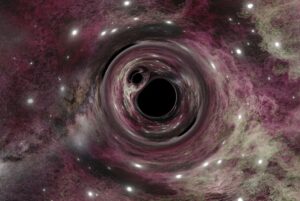International team sheds light on enigmatic nature of these celestial ‘beasts’

A 31.5 solar-mass black hole with an 8.38 solar-mass black hole companion viewed in front of its (computer generated) stellar nursery prior to merging. The distant band of the Milky Way can be seen toward the lower-left of the black hole pair. Light is warped nearby the black holes due to their strong gravity. Credit: Aaron M. Geller / Northwestern CIERA & NUIT-RCS; ESO / S. Brunier
Northwestern University astrophysicists are part of an international team of scientists using advanced simulation tools that has predicted the existence of merging massive, 30 solar mass black hole binaries in Milky Way-like galaxies, challenging previous theories.
The team, which includes Northwestern’s Vicky Kalogera, used the POSYDON code’s recent major advancements in simulating binary-star populations to provide new insights into the formation mechanisms of merging black holes in galaxies like our own. The University of Geneva (UNIGE) led the study; the team also included scientists from the University of Florida and other institutions. PhD candidate Kyle Rocha and CIERA Postdoctoral Associate Meng Sun are also co-authors of the study.
The results were published on June 29 in the journal Nature Astronomy. The study is the first to utilize the newly released open-source POSYDON software to investigate merging binary black holes.
“Models prior to POSYDON predicted a negligible formation rate of merging binary black holes in galaxies similar to the Milky Way, and they particularly did not anticipate the existence of merging black holes as massive as 30 times the mass of our sun,” said Kalogera, a co-author of the study. “POSYDON has demonstrated that such massive black holes might exist in Milky Way-like galaxies, and we have provided a physical explanation for why this is possible.”
Kalogera is the Daniel I. Linzer Distinguished Professor of Physics and Astronomy in Northwestern’s Weinberg College of Arts and Sciences and director of the Center for Interdisciplinary Exploration and Research in Astrophysics (CIERA).
Continue to the full Northwestern News story.

